Getting Started With Facebook Ads
There’s no denying that Facebook advertising gets results, but with so many options a lot of authors are left confused at how to begin or what types of ads they should be spending their money on. Advertising expert Ginger is back this week to help guide you through the options and give you some examples to help make the process easier to understand and get started on. Because after all, if you aren’t advertising your book, you’re unlikely to achieve the level of success you’re probably hoping for.
Understanding Facebook advertising can transform the trajectory of your book – but only if you do it right.
If the Russians can allegedly skew the results of the US election through the power of Facebook, you should be able to sell more copies of your books on ‘the social network.’ With nearly 2 billion active users, there’s perhaps no quicker or easier way to duck through the distractions and get right in front of the people who want to read your book – even if they didn’t know it until that moment.

Last week, we discussed Facebook as a general platform for the self-published author – including the golden rule, which is not to use an account to promote your books. One of the sections we covered was how having an author page on Facebook opened you up to use Facebook’s powerful advertising platform – perhaps the most powerful in the world. Because of the limitations of a blog post, we couldn’t cover advertising as a topic then – which is why we’re going to talk about it today.
Obviously, successfully advertising on a social network like Facebook is a pretty complex topic; but this will serve as a good introduction to some of the fundamental principles.
Why Advertise?
One of the first questions authors have about using Facebook Advertising is – why? If you have access to a free page for your author identity, can’t you just reach readers by posting and interacting?

Well, you can – definitely. In fact, I’m constantly astonished and humbled by the depth of interaction I have with my readers on my pen name’s author page. However, it takes time and effort to constantly keep an author page updated with posts and engagement – especially if you want it to come across as interesting and not too obviously a ploy to sell more copies of your book. Just think of the amount of time you spend on your personal Facebook account. To run a successful author page, you should be investing at least as much as that.
But, even then, Facebook knows it doesn’t want hard work to replace the gleam of cold, hard currency – and so automatically limits the organic visibility of page posts to a maximum of 15% of fans. If you want to reach a larger percentage than that, you have to pay.
(And, yes – I think it’s outrageous. Facebook promote advertising to get your page more fans and followers – and then ‘double dips’ by forcing you to pay to interact with the fans you’ve already paid to acquire!)
When you’re first starting out as an author on Facebook, you can achieve a lot through posting and interaction – you’d be astonished. When you become more established, though, there’s a law of diminishing returns. You can still definitely see the impact of all your posting and hard work – since 15% of 1,000 fans is still 150 people. However, to really impact the largest group possible, Facebook has been specifically engineered to force you to reach into your pocketbook. This is why knowing about advertising is important – because since it’s so essential for success, you want to get as much value for your money as possible.
Buyer Beware
Facebook are more than happy to take your money. If you want something in return for it, you should make the effort to educate yourself and manage your expectations. I remember when I first approached advertising on Facebook. I was so buoyed by the success that author Mark Dawson had shown examples of, that I immediately assumed I’d have the same degree of success. I threw hundreds of dollars at Facebook expecting an easy 100% return on it.
I was disappointed – and also considerably poorer!
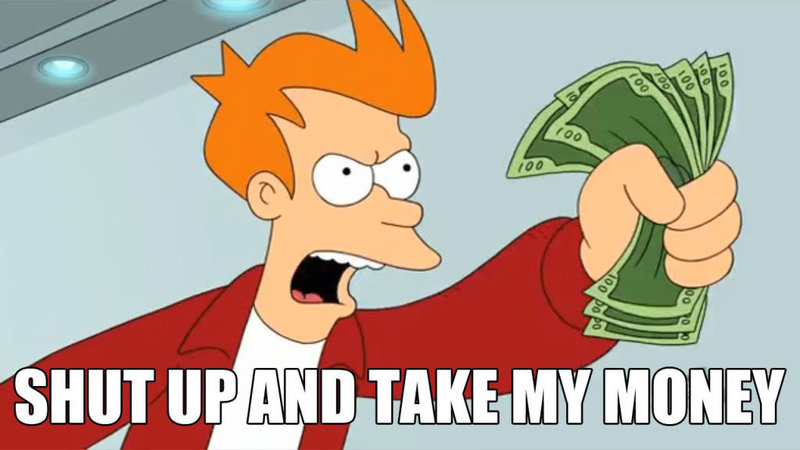
I’m happy to say that today, I’m more than satisfied with the performance of my Facebook advertising (actually listening to the entirety of Mark Dawson’s course – instead of just the first chapter – helped significantly.) Facebook could very well deliver the results you want – eventually. But understand that spending – and losing – money is normally a very important first step towards reaching that goal.
Never spend any money on advertising that you need to get back. If you’re smart, consistent and careful, you will certainly reach the stage in which you can expect to get it back – but given that Amazon only pays 60 days after the end of the month – and most mortgage companies need their money sooner – it’s important to think about how cash flow works in the context of your daily life, and how lack of cash flow might impact it.
Never spend money you don’t have.
How to get started
Getting started advertising on Facebook used to be much simpler than it is today. To get started though, you’ll first need a page for your author identity. If you’ve read this far, I’m going to assume you’ve already taken care of that.
Facebook will make it easy to get started on the route of advertising, by hitting you up for money like an old boyfriend. Almost as soon as you publish your page, they’ll offer to take your money to gain more followers, or insist that you ‘boost’ your first post.
Following their prompts will take you fairly far – but the recent change that’s caused a lot of people headaches is the requirement for each page to be linked to a Business Account.
What is a business account? All it really is, is a link between a real-life Facebook account, with an associated credit card and legal details, and the page you want to advertise. This is just one more reason why it’s a hard and fast rule that you never use a Facebook account – especially one for a fictional pen name – to manage your book promotion. Link your real account to your author’s page – and if you publish anything off-color, be reassured that the link will only be visible to yourself and anybody you choose to share it with.
Once you’ve got yourself set up, you can access the Ads Manager for Facebook from the top-right menu; by clicking on Manage Ads.

What can you advertise for on Facebook?
Okay, so you’re into the system. What next?
As an author, selling books is the most obvious reason you may want to advertise on Facebook, but there are actually other reasons as well. In fact, there are at least four advertising goals most relevant to a self-published author when using Facebook:
- Advertise for more followers and fans
- ‘Boost’ a post you make (give it more visibility)
- Promote or advertise your book
- Increase the subscribers to your mailing list
Fans / Likes
As soon as you publish your page on Facebook, the Zuckerbots are going to hit you up to advertise and acquire more ‘fans’ for your page. The most important thing you need to know about using this method of advertising is not to bother.
If you’re a public figure – or an Instagram model – there might be value to the perception that your page has tons of fans and followers. If you’re an author – interested in people buying and selling your books – that’s certainly not a necessity. Aside from vanity, the benefit of ‘buying’ fans and followers is diminished significantly by the fact that you can only reach 15% of them organically. In essence, you’re paying to gain more fans for your page – and then having to pay again to advertise to the fans you’ve already paid for!
Compounding that issue is the fact that you can very easily leverage any of the other advertising you do to gain those followers and fans organically. Every ad that you post appears in the Facebook feed as a regular Facebook post from your author page. Therefore it can be liked, commented on, and shared by all who see it – even if they’re not currently a fan or follower of your page. You can very easily then click on the list of people who’ve commented or liked on your page, and invite each of them to ‘like’ your author page without having to pay any money whatsoever. A great many of them might have clicked ‘like’ already. Therefore, by merit of simply advertising on Facebook in the first place, you’ll automatically see the number of fans and followers your author page has gradually increase.
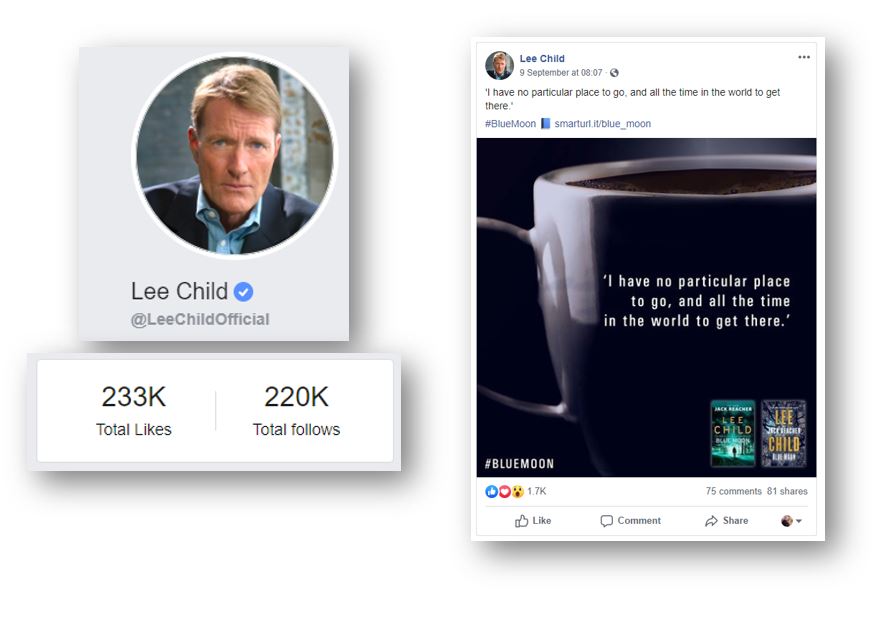
Boosted Post
The next way the Zuckerbots try to take your money is by offering to ‘boost’ the first thing you post on your author page. To ‘boost’ a post is simple – you just click on the big, blue ‘boost’ button if Facebook haven’t already urged you to do so (but trust me, they will have.)
When you ‘boost’ a post, you make it visible to a larger audience. Sickeningly, the first audience you get offered the chance to pay to reach are your own fans (because remember, only 15% of them will see it organically.)
Next, you’ll be offered the chance to post to friends of your fans – this, at least, means you get to reach an audience you haven’t previously interacted with.
Finally, you’ll be offered the opportunity to reach a more general audience, either from one of your custom audiences (more on those later – they’re great!) or a more general audience you select through targeting. Whichever one you choose is up to you – the suitability of each audience depends on who you’re trying to reach, and what you want them to do.
You can also add a button to a boosted post – which can direct to a specific webpage, like your author website, the product page of a book, a landing page for your subscriber list – or anything more original you can think up!
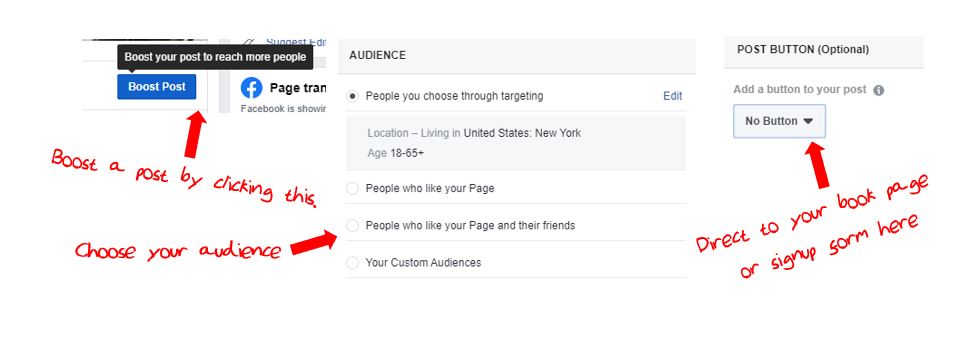
And really, that’s where the value of boosted posts comes in – for ‘anything more original you can think up.’
If your goal for advertising is to sell more books, boosted posts are not the way to go. While you can select an audience as tightly as you can with a custom ad, and you can promote exactly the same books or links, I’ve never found a boosted post to be as effective at driving traffic to a book page as an actual advertisement I’ve made in the Ads Manager. An example? For clicks through to one of my last books, a customized ad was generating clicks to my book’s product page at a rate of $0.09 each – less than a dime! In comparison, when I told my organic audience about a new book, and threw some money at boosting that post, the price for each of those clicks was $1.05 each!
On the face of it, that doesn’t make much sense – the content of the ads were almost identical. The difference is that ads you create in Ads Manager have a specific purpose, like driving customers to a product page, and are optimized and delivered to your audience with that goal in mind. Boosted posts default towards the goal of engagement – likes and comments, in addition to clicks – and therefore you might get a lot of traction on that post, but not that many useful actions.
But that’s fine! I use boosted posts to promote cover reveals, recruit new ARC readers, or just interact with fans via a survey question or something else engaging. It’s not that boosted posts don’t have value – it’s just that the value they offer is targeted specifically towards engagement to your post. If you have different goals in mind, you really should be using Ads Manager.
You’ll have to use your own best judgement for this – but don’t listen to Facebook’s enthusiastic suggestion to ‘boost’ a post unless you have a clear understanding of what it is you’re trying to achieve with it.

Selling Books
By far and away the most common reason authors want to advertise on Facebook is to sell books – and that’s something that you can achieve. If you’re good – and, more importantly, your book is good – you can actually use Facebook as a way to profitably sell books; as in, spend less money advertising them than you receive in the royalties from Amazon.
It can be done. It is done. Many authors – most notably the crown prince of author advertising, Mark Dawson – have made it one of the mainstays of their writing career. However, to do so is far from easy, and there is a steep learning curve.
To make an effective book ad, you’ll first need to go to your Ads Manager by clicking on the top right corner menu. Then, when the menu of Considerations comes up, you’ll want to select Traffic. The purpose of this ad is to drive traffic – in the way of clicks – to your product page on Amazon.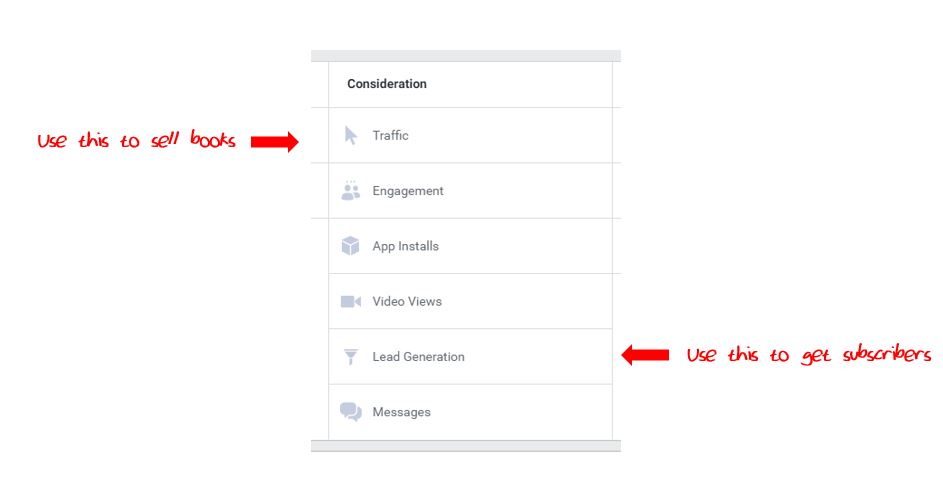
Once you get through that stage, you’ll need to create your Campaign. A Campaign is like a book, which encompasses the entirety of this advertising effort. Make sure to name your campaign something timely and clear – don’t just go with the default name of Traffic – and then you’ll be directed to the section called Ad Sets.
An Ad Set is like the chapter of a book – you can have multiple ones within the same Campaign. In the Ad Set, you can specify the audience you’re advertising to, the budget, and other details like where the ads will feature, and which page will host them (that’s your author page.)
Finally, you’ll move onto the Ads section, where you create your actual ad – the thing that will appear to potential customers. Again, you can have multiple Ads within the same Ad Set, so you can test out different creative approaches using the same audience and budget.
Unlike boosted posts, Ads are designed for one specific purpose – to sell books. You’ll select artwork – or let Facebook scrape it for you – and then throw in some copy. .
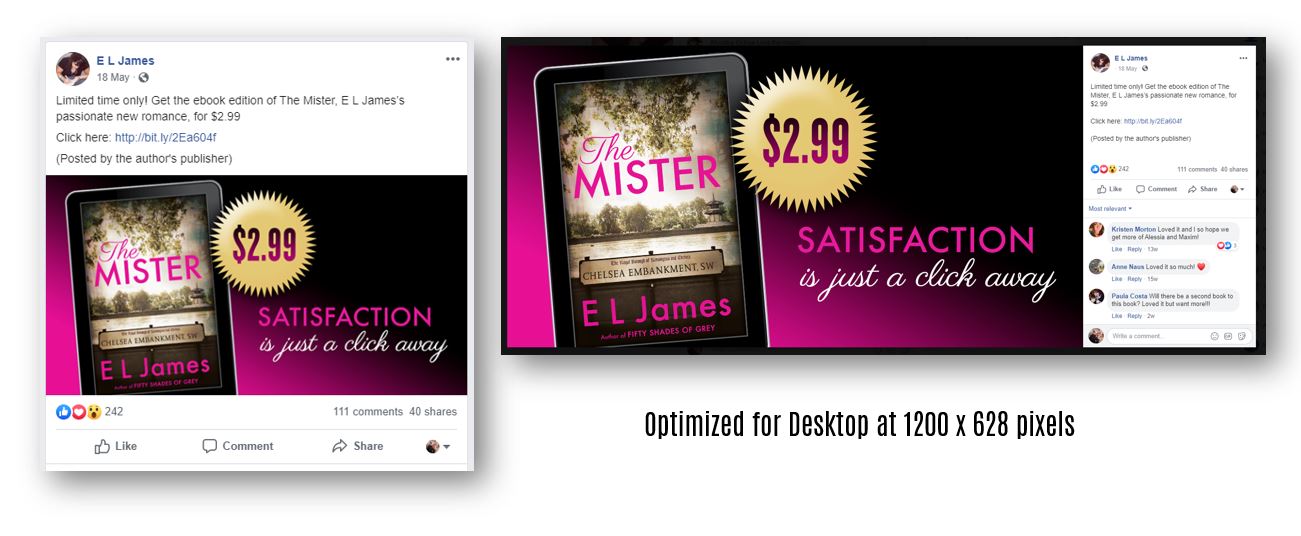

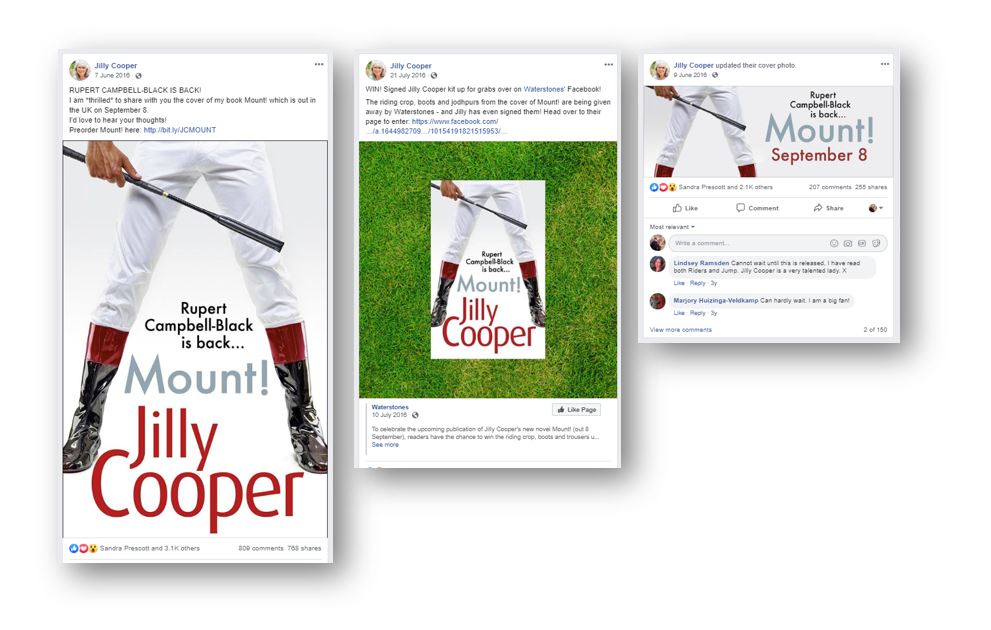
The subtleties of advertising are more than can be explored in a single blog post, but the basic advice I’d give to people is this:
- Keep your advertising copy short and punchy – ads with a single line of copy perform better than ads with longer copy (and Facebook doesn’t allow much text on your actual ad image).
- Use your Book Cover – ads which feature the book cover in the context of a 3D render of a paperback, or even on a Kindle, convert better.
- Don’t include affiliate links to your book – Amazon will ding you for this. You can use tags and suffixes to help you identify traffic better, however.
It’s worth noting that the longer you run an ad, the more it’ll collect comments, likes and shares – so it’s often beneficial to create a long-running advertisement, as this will drive fans and followers to your author page. You can also click on the likes, comments and shares to invite those users to like your page directly.
You can examine the results in Ads Manager to see how many clicks your ad is sending through to your product page, and how much they’re costing you. It’s then up to you to figure out how many book sales that translates into, and whether or not you’re turning a profit. Facebook doesn’t allow you to track this , unlike Advertising on Amazon, and in keeping with AMS also doesn’t track page reads that originate from this ad. Comparing the results of a month in which you didn’t advertise on Facebook against a month in which you do can help you see if your advertising is working or not – and if you’re making more money than you’re spending.
Ultimately, the trick to profitable advertising on Facebook is the same as anywhere else – it’s all about the conversions. Graphics, copy and the all-important audience are important for driving clicks through to your book’s product page – but if the product page doesn’t entice that traffic to click ‘buy now’ it’s all for nothing. If you’re getting plenty of clicks, but not that many purchases – that might be the issue.
Again, one good rule of thumb is not to assume that you can or will see a return on your investment. I personally invest the majority of my Facebook advertising into the free promotional days my book is eligible for by being part of KDP Select. I realize I’m not going to see any return on that investment – I’m literally giving the books away – but the download rate and the way in which the books get fed into Amazon’s organic Also Bought algorithm makes me feel like it’s a good use of my money.
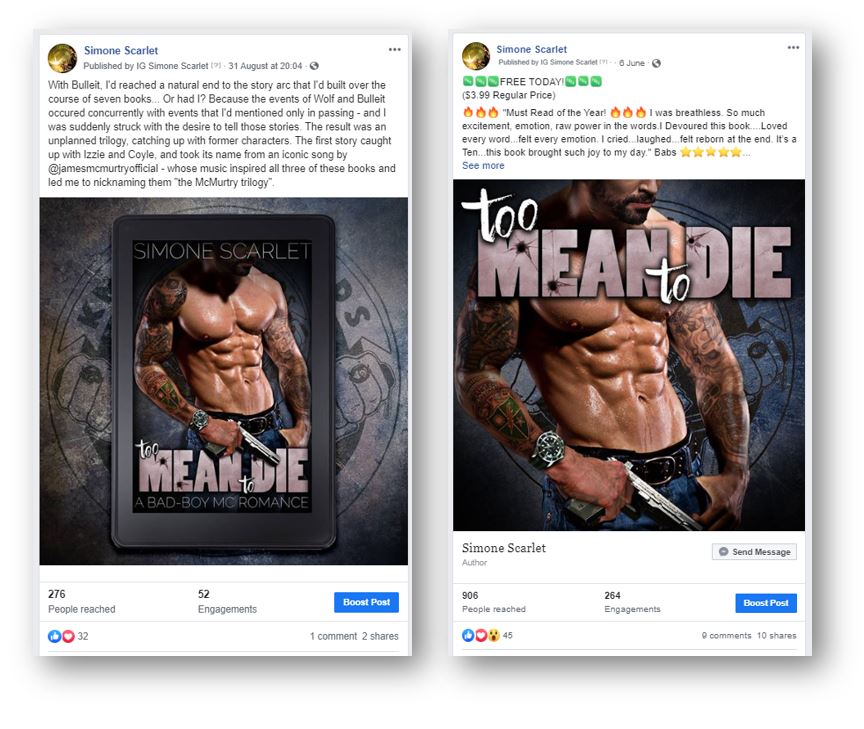
Subscribers
One of the most powerful ways to use Facebook advertising is in building your subscriber list. Any successful author will know the power of a mailing list – the direct email addresses of fans and readers – and the larger it grows, the harder-hitting the impact of each book release is. There’s a common theory that it takes 10,000 subscribers for an author to being self-sustaining – as in, earning a six-figure annual income – but to get to that level organically is ambitious.
So, why not leverage the power of Facebook? That’s exactly what I do – as do many other authors. Our guest blogger Simone Scarlet volunteered graphics from her Facebook advertising and a post promoting her subscriber list signup. This runs continuously, day-in and day-out, and earns her a number of signups each and every day.
To start an ad to promote signups to your mailing list, you’ll once again click on the Ads Manager link, and the button to start a Campaign – but this time you’ll select Lead Generation instead of Traffic. By doing this, Facebook will seamlessly collect the email address and any other information when somebody clicks the ‘Sign Up’ button.
You can link your Facebook page to your Mailchimp account, to automatically feed all new subscribers to your mailing list, and for best results you should also offer an incentive – for example, Simone Scarlet offers a free download of her first three books. She uses Bookfunnel to achieve that, and a successful subscriber is directed to the download page the moment they’ve submitted their information. You’ll also need to supply Facebook with a Privacy Policy. You can find a free privacy policy online to customize for your subscribers – the issue will be where to host it. If you have a page for your author name, you can simply create a link there. Otherwise, it’s worth looking into free or paid hosting to create one.
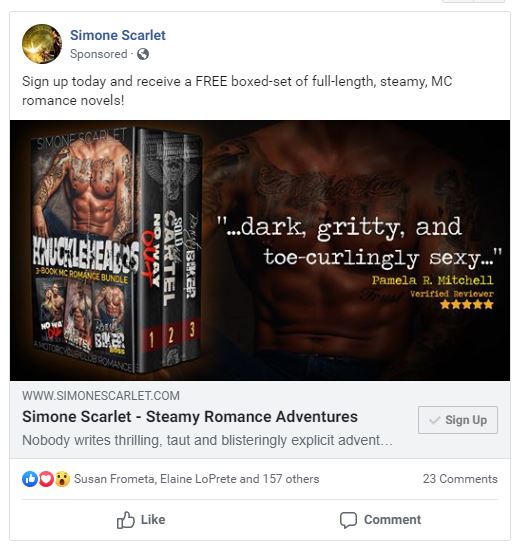
A subscriber list is a powerful thing, allowing you to send out regular newsletters (which should be part of your overall marketing plan) and thus more than justify the fact that they often cost more per signup than a click through to your book’s product page on Amazon. After all, once you have these fans as subscribers, you can hit them up each and every time you launch a new book – turning that upfront cost into a really smart investment of your advertising budget.
There are additional benefits too, but the one in particular that stands out to me is in using your subscriber list to create a customized audience to advertise to on Facebook; ramping up the effectiveness of your advertising, and driving down the cost.
In fact, advertising to the correct audience on Facebook is possibly the key to any successful advertising campaign – and there’s a powerful way in which they help you find that audience.
Finding the Correct Audience
By advertising on Facebook, you get the opportunity to reach a potential audience of nearly 2 billion people – but how many of those people are likely to want to read your book?
The truth is – not as many as you’d like, and you don’t want to spend money putting your ad in front of them.
Making sure that Facebook only places your ad in front of people who are likely to click on it is one of the most important parts of advertising on Facebook effectively, and it’s also one of the least-popularized ways to optimize your ads. I feel like I’m giving away a trade secret by sharing this – but it has the potential to radically transform the effectiveness of your advertising.
Okay, so when you are creating your ads – whether they’re a boosted post, designed to sell copies of your books, or collect subscribers – you’ll be asked to select an Audience. You can use a complex drop-down list to create a customized audience based on geography, native language, interests and demographics – even down to whether they own a device like a Kindle!
You can achieve great things by using these customization – but there’s a better way. A much better way.
Remember, Facebook owns you. They know everything about you – from your family situation, job and friends list to your likelihood of clicking on ads, or even what you talk about through Facebook Messenger! (Don’t lie, I know you’ve been creeped out before when you’d spoken in private to somebody about a book, movie or product – and then seen that exact thing advertised in your feed!)
If you have some information about the kind of people who are interested in your books, you can use that information to create what’s called a ‘Lookalike Audience.’ This is an audience of potential readers that is tailored exactly to your existing audience – in ways so subtle you might not have even thought about it yourself. Using the regular audience creation tool, you can select books that readers might like, or TV shows or music… But Facebook’s Lookalike algorithm can identify things like whether or not your audience is likely to have siblings, what kind of car they look up when they’re ready to buy a new one, their level of education or even if they have a pet or not.
These things might sound meaningless – but they’re not. If Facebook and social media has taught us anything, it’s that no patterns are meaningless. If 90% of your readers own a cat, for example, it’s not a coincidence. Cat owners are more likely to read your book! With the power of a Lookalike audience, you can identify a more responsive audience in ways that no human brain could possibly think of – and it works.
To create a lookalike audience you’ll need at least 100 Facebook users (although the more you have, the better the results as it gives a larger sample size to match against) to start with – identified either by interaction with your author page, posts, or ideally an email address. This is actually one of the reasons why using Facebook advertising to find subscribers is so powerful – because as soon as you’ve got those first 100 signups, you can feed that information into Facebook and find more of the same!
To create a lookalike audience, click on Create New Audience in the Ad Set portion of the Ads Manager, and follow the instructions to add in your list of users – for example, I’d copy and paste them in as a Customer List. You’ll have to tell Facebook where you got this list from (in my case, directly from the customers themselves) but then they’ll seek out the 100+ Facebook users and start building the Lookalike audience.
You can drill down to specify how alike you want this audience to be – from a tight 1% similarity (this is what I use) to a much broader 10%. Even just 1% of the potential audience normally generates around 2 million potential customers, so you can see just how powerful this tool can be when you use it to base your advertising audience on.

As your advertising campaigns mature, you can drill down even deeper. For example, I have an audience of people I’ve identified from my Mailchimp subscribers who have clicked on the links for my latest books, knowing full well that they cost the most to purchase and read. This means the audience Facebook identifies for me will likely have similar patterns of behaviors – a willingness to spend money on books – making them a much more powerful group to promote my latest release to.
If you want to know how effective a properly-tailored Lookalike audience can be, you only need to look at the results you get for your Cost Per Click or Cost Per Lead. In my case, I went from spending $1.00 per new subscriber, to an average of $0.30. Simone Scarlet reported that her Cost Per Click when advertising new books dropped from $0.80 per click with the audience she’d selected herself, to an incredible $0.08 per click. That’s significantly cheaper than even Advertising on Amazon will deliver.
Getting your audience right is the difference between blowing a ton of money on Facebook advertising, or investing it. I will often tell people who book an advertising consultation session with me that it’s worth spending up to $2.00 a lead on a Facebook lead generation ad simply to get those first 100 subscribers – because then you can cut your cost per lead in half, or even better.
Facebook – as powerful as you make it!
As a 20-year veteran of the advertising industry, I’ve seen it all – and I’ve learned a lot and made a lot of mistakes along the way. One of those lessons is that it’s worth taking the time and investing the effort to fully understand how Facebook advertising works; because it’s initially easy to get disheartened and give up.
You’ll lose some money and some sleep in the process – but once you’ve found a good groove, Facebook Advertising can be one of the most powerful and effective ways to promote your book and your author identity. I use both, but if I had to pick between the two I’d even say Facebook is a more effective advertising platform than Advertising on Amazon right now. It’s got the versatility and customization that Amazon’s platform doesn’t; and I can reliably get better and cheaper results with it thanks to the tips and tricks I’ve learned over the years.
Your mileage may vary – but if this is an avenue you want to explore, you don’t need to stumble along and make all the same mistakes I did. Book a 1-to-1 consultation call with me and I can get you started.





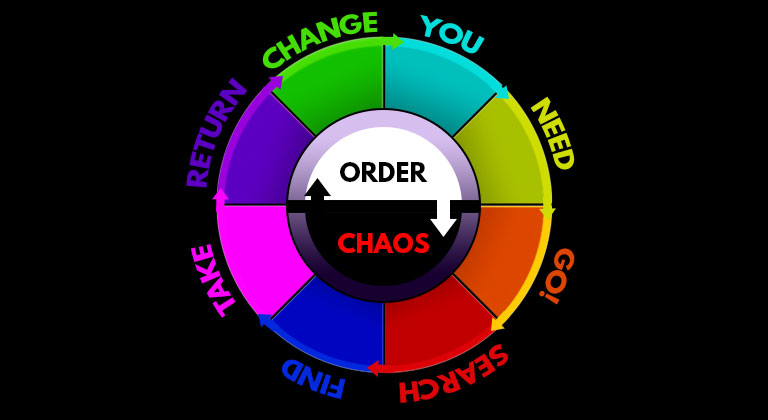


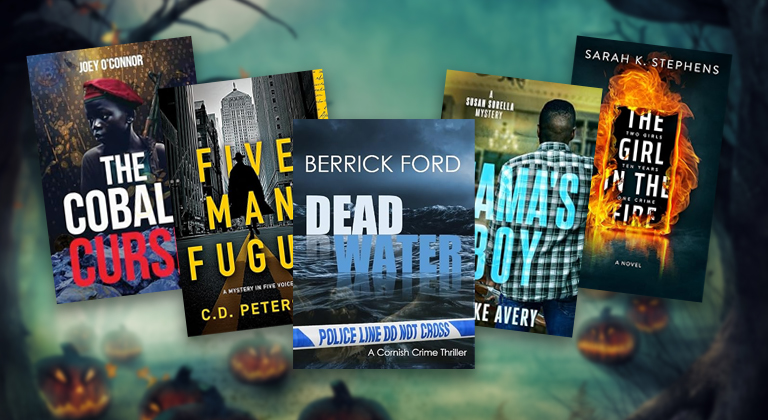

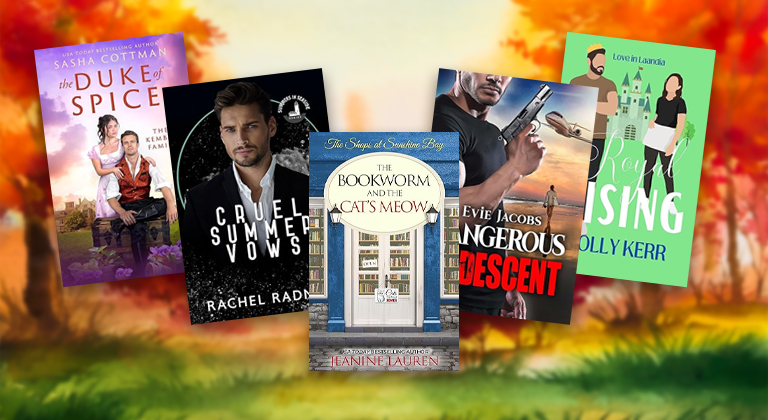

3 Comments